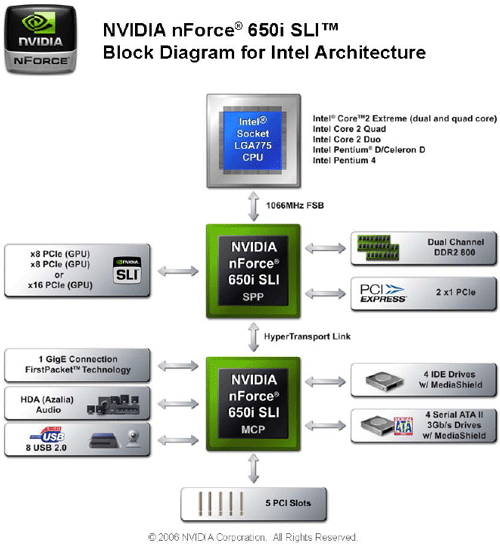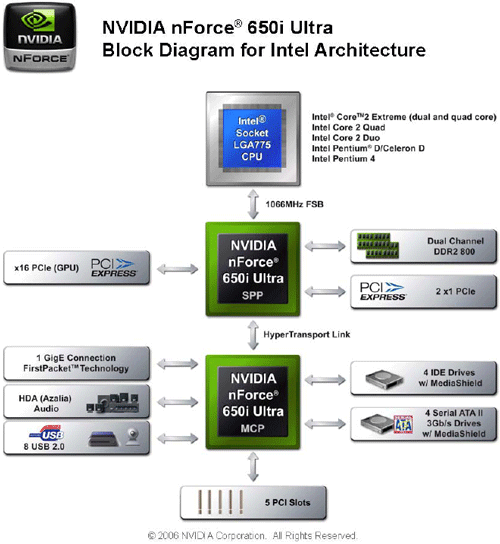NVIDIA 680i: The Best Core 2 Chipset?
by Gary Key & Wesley Fink on November 8, 2006 4:45 AM EST- Posted in
- CPUs
nForce 650i SLI & 650i Ultra
For buyers not interested in the top-end features or top end price of the 680i, NVIDIA will offer two additional models at lower price points.

The 650i SLI, which will sell in the $150 to $199 price range, will support a single x16 PCIe video card, or SLI with two video cards driven by two x8 PCIe slots. PCIe lanes are reduced to 18, SATA-II ports from 6 to 4, USB 2.0 from 10 to 8, and it comes with a single Gigabit Ethernet port instead of the two with teaming on the 680i.

The nForce 650i Ultra, designed to sell in the $99 to $149 price range, offers a single x16 PCIe slot in 18 total PCIe lanes. Features are otherwise the same as the 650i SLI.
While there is some overlap in market segments, the 680i is designed to compete with the Intel 975X premium motherboards while providing dual x16 SLI graphics compared to dual x8 CrossFire on the 975x. The 650i SLI should compete with premium Intel 965 boards, while the 650i Ultra will compete with low-end or entry-level P965 motherboards.
For buyers not interested in the top-end features or top end price of the 680i, NVIDIA will offer two additional models at lower price points.

The 650i SLI, which will sell in the $150 to $199 price range, will support a single x16 PCIe video card, or SLI with two video cards driven by two x8 PCIe slots. PCIe lanes are reduced to 18, SATA-II ports from 6 to 4, USB 2.0 from 10 to 8, and it comes with a single Gigabit Ethernet port instead of the two with teaming on the 680i.

The nForce 650i Ultra, designed to sell in the $99 to $149 price range, offers a single x16 PCIe slot in 18 total PCIe lanes. Features are otherwise the same as the 650i SLI.
While there is some overlap in market segments, the 680i is designed to compete with the Intel 975X premium motherboards while providing dual x16 SLI graphics compared to dual x8 CrossFire on the 975x. The 650i SLI should compete with premium Intel 965 boards, while the 650i Ultra will compete with low-end or entry-level P965 motherboards.










60 Comments
View All Comments
Wesley Fink - Thursday, November 9, 2006 - link
The other time you might need a fan on the northbrdige is when using water cooling or phase-change cooling. There is no air-flow spillover from water-cooling the CPU like there is with the usual fan heatsink on the CPU, so the auxillary fan might be needed in that situation.Wesley Fink - Thursday, November 9, 2006 - link
The 680i Does NOT require active notrthbridge cooling and is shipped as a passive heatpipe design. At 80nm it is much cooler than the 130nm nVdia chipsets. The fan you see in the pictures is an included accessory for massive overclocking, much like Asus includes auxillary fans in their top boards.In our testing we really did not find the stock fanless board much of a limitation in overclocking as the northbridge did not get particularly hot at any time. We installed the fan when we were trying to set the OC record and left it on for our 3 days at 2100 FSB. Since it is a clip and 3 screws to install we left it on.
IntelUser2000 - Monday, November 13, 2006 - link
That's funny. A cooler running one consuming more power. Must be the die size is much larger :D.
yacoub - Thursday, November 9, 2006 - link
ah okay thanks for that clarification! =)yacoub - Thursday, November 9, 2006 - link
NTune would be a lot more interesting if it wasn't so slow to respond to page changes, cumbersome, and a gigantic UI realestate hog.The same functionality in a slimmer, more configurable, and efficient UI design would be highly desireable.
yacoub - Thursday, November 9, 2006 - link
and actually, that goes for the entire NVidia display/GPU settings configuration panel.Khato - Wednesday, November 8, 2006 - link
Each CPU is going to have a max FSB clock that it'll run stably at for the same reason that it has a max core logic frequency. The main difference here is that you have two possible barriers: signal degredation due to the analog buffers not being designed for such high speed and then whatever buffer logic there is in the CPU to clock cross from FSB to core not liking the higher frequency. I'm kinda leaning towards the buffer logic being the limiting factor, since I'd expect the manufacturing variance in the analog buffers to be minimal. That and the described 75MHz variance in top FSB frequency between various processors sounds reasonable for non-optimized logic.Staples - Wednesday, November 8, 2006 - link
I have no need for SLI. Makes the board more expensive and an SLI setup is just not worth it to me. I was about to buy a P965 chipset but now I am interested in a the 650i Ultra. Will we see a review of this chipset in the future? Most of it seems to be exactly the same as the 680i however it does lack some features and I am afraid that those missing features may affect performance. As it stands now, do you expect the performance of the 650i Ultra to perform identical to the 680i SLI?Gary Key - Wednesday, November 8, 2006 - link
We do not, we do expect the 650i SLI to perform closely to it. We will have 650i boards in early December for review. :)
Pirks - Wednesday, November 8, 2006 - link
is this functionality where you can overclock your CPU and FSB and memory on the fly without rebooting Windows available only on nForce mobos? I'm a stability freak and I want to be able to raise and lower my clocks and voltage on the fly, similar to the way Macs do this - they spin their fans under load and become totally quiet when idle - I wanna do the same so that my rig is dead quiet when idle/doing word/inet/email/etc and becomes noisy and fast OCed beast when firing up Crysis or something. and I want this Mac-style WITHOUT rebooting Windowsso do I have to buy nVidia mobo for that?
600i series only or earlier nForce 4 or 5 series will do as well?
I still can't dig what's up with these "dynamic BIOS updates that _require_ reboot to work" - so can you OC without rebooting or not? if yes - what are these BIOS options that nTune changes that DOES require reboot?
could you happy nTune owners enlighten me on that stuff? thanks ;)